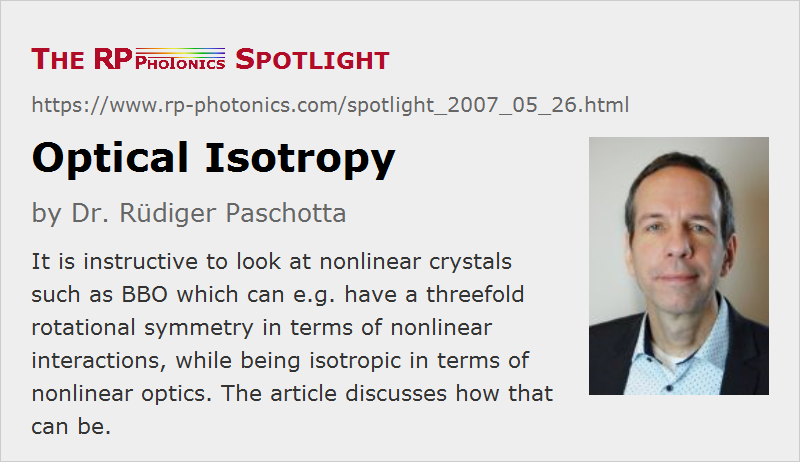Optical Isotropy
Posted on 2007-05-26 as part of the Photonics Spotlight (available as e-mail newsletter!)
Permanent link: https://www.rp-photonics.com/spotlight_2007_05_26.html
Author: Dr. Rüdiger Paschotta, RP Photonics AG, RP Photonics AG
Abstract: It is instructive to look at nonlinear crystals such as BBO which can e.g. have a threefold rotational symmetry in terms of nonlinear interactions, while being isotropic in terms of nonlinear optics. The article discusses how that can be.

Ref.: encyclopedia articles on nonlinearities, birefringence, nonlinear crystal materials
Consider a laser beam propagating through a BBO crystal along its c axis. BBO is uniaxial, so the refractive index will not depend on the polarization direction of that beam. There is no birefringence.
Now consider the nonlinear properties. Here it does matter quite substantially how you rotate the crystal around its optical axis: for certain orientations, there is no χ(2) nonlinearity at all, for others it has a maximum. (You can't use that for nonlinear frequency conversion, as phase matching is not possible for that propagation direction, but let's ignore that here.) You find a threefold symmetry, corresponding to the trigonal crystal symmetry. No isotropy in this respect!
In fact, the linear optical properties often exhibit a higher symmetry than the nonlinear properties. Why is that? Consider the relation between the polarization of the medium and the electric field of a light beam. A linear relation is described by the linear susceptibility tensor of rank 2. Considering only two dimensions, we have only four tensor components. If we have a crystal exhibiting the same refractive index in two orthogonal directions, this tensor must be diagonal, with the two diagonal components being equal, and it is mathematically impossible that the refractive index is different for any other polarization direction. Also, you can never have e.g. a threefold symmetry, even if the crystal is trigonal. The higher-order tensors corresponding to nonlinear interactions, however, have many more components, and there is a lot of freedom for more complicated angular dependencies.
So we should keep in mind: optical isotropy concerning linear properties does by no means imply that all directions are physically equal. This is revealed particularly by nonlinear interactions. And of course it is obvious when looking at the crystal structure: have you ever seen a crystal with rotational symmetry?
This article is a posting of the Photonics Spotlight, authored by Dr. Rüdiger Paschotta. You may link to this page and cite it, because its location is permanent. See also the RP Photonics Encyclopedia.
Note that you can also receive the articles in the form of a newsletter or with an RSS feed.
Questions and Comments from Users
Here you can submit questions and comments. As far as they get accepted by the author, they will appear above this paragraph together with the author’s answer. The author will decide on acceptance based on certain criteria. Essentially, the issue must be of sufficiently broad interest.
Please do not enter personal data here; we would otherwise delete it soon. (See also our privacy declaration.) If you wish to receive personal feedback or consultancy from the author, please contact him, e.g. via e-mail.
By submitting the information, you give your consent to the potential publication of your inputs on our website according to our rules. (If you later retract your consent, we will delete those inputs.) As your inputs are first reviewed by the author, they may be published with some delay.


Share this with your friends and colleagues, e.g. via social media:
These sharing buttons are implemented in a privacy-friendly way!